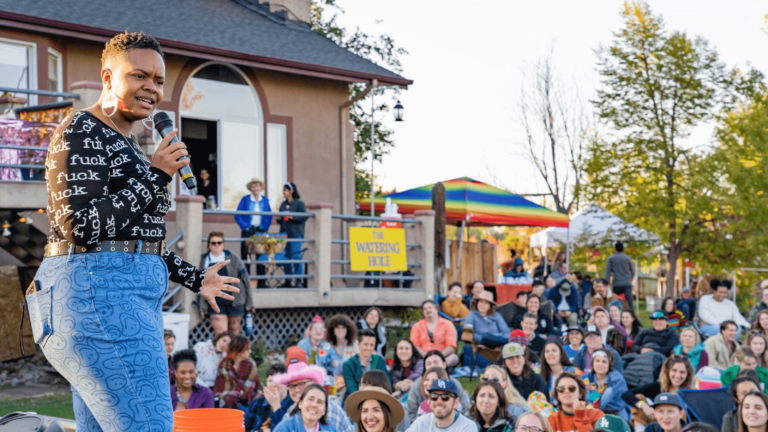Impactful events bring us together.
Whether you’re raising money for a great cause, showcasing fresh talent, or celebrating pride within a community — as an event creator, you’re in the unique position to unite people and empower communities through shared experiences.
However, if you want to create events that change lives, you’ve got to start building your following and creating a community.
That’s where we can help you.
At Eventbrite, we support a diverse mix of event creators all over the globe who create meaningful and memorable events for the communities they serve. Read on to find out how you can do the same. We’ll also break down 14 essential ways you can grow your following and build a sense of community around your events.

Event planning basics: where do you start?
No matter how unique or quirky your vision may be, to succeed in creating truly great events you need to lay a good foundation. All events have one thing in common: they need preparation. Bearing that in mind, let’s take a step back and look at the foundational event-planning steps required to make your next event a roaring success.
Getting started with your event plan
Event preparation is all about laying the groundwork to transform your vision into a reality. That journey starts with creating an event plan. Event creators use event plans like a construction blueprint — the plan guides the entire process from inception to post-event review.
Your event plan should include information such as:
- An event overview (like your date, time, location, and venue)
- Event goals (e.g. promote your venue or raise funds for charity)
- A profile of your potential attendees
- Your event’s unique value proposition
- An event marketing timeline
- Event metrics you’ll use to chart your success
- An event budget
- Event staff
- An event health and safety plan
Just remember that no two events are 100% alike, and so you might need to add some additional sections that’ll help guide the other stages of event planning you’ll undergo.
If you need help getting started, try using an event planning template.
Event promotion and ticketing
Once you’ve written an ironclad event plan, it’s time to start promoting your event.
Your first step must be to choose a promotion and ticketing partner. Unless you’ve got a huge team with nothing but time on their hands, handling promotion and event ticketing manually can be a huge drain. That’s why it pays to use event management software that can streamline these processes.
For example, with Eventbrite, you can set up a custom event page, create different types of tickets or reserved seating arrangements, and start selling tickets in a matter of minutes. From there, tickets are sent out to your customers automatically — meaning you don’t have to lift a finger.
This frees you up to focus on putting together and executing a strong marketing plan. Start by developing a marketing budget and conducting market research to figure out where you’ll be able to reach your target attendees.
From there, you can create ads targeting that audience so they can easily find your events on Eventbrite or connect with them on your chosen social media channels. With Eventbrite you can automate social media promotion, sync your email communications with your ticketing platform, and much more.
Post-event review
After the show is over you’ve got to conduct a post-event review. This analysis will allow you to look at your event in the cold light of day and decide what to keep and what to toss before your next big event.
Access to good data is essential for a balanced review, so it’s important you keep detailed records throughout your event planning process and execution. Again, this is where it pays to partner with an event management platform like Eventbrite.
Eventbrite captures tons of ticket holder data and information about how potential attendees engaged with your advertising and your event page. You can use that data to generate custom reports that tell you how long people spent on your event page, which websites or social media campaigns they engaged with, how many ticket holders checked in, how many people arrived late, and more.
By looking at this data, you’ll be able to tell whether you achieved your event goals — and figure out what you can do better next time.
How to build buzz around your event in 14 steps
Now that we’ve covered the basics on how you can lay the foundation for any type of event through careful planning, let’s dive deeper into some less obvious aspects of event planning.
In this case, we’re specifically looking at ways you can build a community around your events to help you engage followers and sell tickets all year round.

1. Create a sense of purpose around your event
Pay attention, because this one is important: If you want to grow your following and create excitement around your event, you’ve got to give people a good reason to get excited.
What do you want your event to achieve? It may sound obvious, but staying focused on the purpose of your event from the outset will help you to achieve your vision — and with so many events out there, those with a real sense of purpose are the ones that make a mark.
According to researchers at IPSOS, 80% of consumers only support brands that align with their values. So, think about what those values are — the “why” behind your event.
Do you want to showcase your commitment to sustainability by creating a carbon-neutral event? Do you want to demonstrate your support for women in business by creating a conference with all women guest speakers?
By showcasing those values, you’ll be able to connect with the communities you care about.
For example, take a look at event creator Moon Rise Run. When setting up their first evening 5k in Manchester, Event Director Sally Pigott said the event team’s goal was simple: to create an inclusive opportunity for people to experience night running in a fun and safe environment.
By building their event around a core purpose and making it accessible, organisers created a unique and successful event nobody will ever forget.
💡Pro tip: Not sure how you want to build an ethos around your event? Conduct some market research. You can survey your target audience on what matters to them most by organising an online focus group of people interested in your event.
2. Develop content that aligns with your purpose
You should be looking at your web content on two fronts: the composition of your event and its line-up and the messaging you’ll use to market the event. Both need to align with your purpose.
That means choosing guest speakers and entertainment that align with the ethos of your event. For example, if you’re setting up a conference to connect Black artists, you might invite a keynote speaker with a reputation for celebrating Black excellence. Likewise, if you’re setting up a folk music festival, you’re not going to want to book a heavy metal band.
Meanwhile, you’ve got to ensure you’re crafting messaging and event branding that’ll position your event in the best possible light. Every video, social media post, email, and webpage you populate needs to fit in with your brand personality, voice, and the event’s purpose.
💡Pro tip: Not sure how to develop the content for your event? Don’t be afraid to ask for help. Get in touch with industry experts, like-minded businesses, or event sponsors to find out what sort of content they think deserves a place at your next event.

3. Choose dates and timings that cater to your audience
Nailing down these key details early in the event process will mean you can share them with potential speakers or guests, creating a clearer and more valuable proposition.
Think about what you require from the venue (location, accessibility, kitchen facilities, alcohol license, and so on) and the time of year best suited to your event, then start reaching out to potential venues.
If your event is taking place virtually, think about the platform that you might use. Zoom is great for handling a large number of attendees, while Vimeo gives you access to slick interactive features like Q&As and polls.
💡Pro tip: In addition to availability, you’ve also got to make sure your chosen venue isn’t simply a vessel for your event. It should add value too. Booking a seasonal venue that caters to your event theme will create ambiance and enhance your attendee experience.
For example, hiring a pumpkin patch or a working farm to host a Halloween party would add an autumnal atmosphere to your event.
4. Let your community know they’re safe
If you’re hosting in-person events, you need to make sure you’re covered for all eventualities by conducting a risk assessment and drawing up a health and safety plan to protect suppliers and attendees from potential problems.
It’s particularly important to show customers that you’re walking the walk on inclusiveness. You’ve got to create an environment that’s safe, healthy, and accessible for every single attendee.
By making sure everyone is included and their needs are met, you’ll demonstrate your commitment to your community of followers and build up support for your brand and its ethos.
Although these adjustments and risk assessments largely centre on in-person events, it’s also important to consider the safety and accessibility of any hybrid events or virtual events you’re hosting.
For example, consider sharing a list of virtual event rules and your code of conduct with attendees before the big day.
💡Pro tip: Accessibility measures aren’t just a nice gesture to make sure all of your guests are included. It can also be a regulatory obligation you need to abide by.
Make sure you consult experts in this space like the UK’s Equality and Human Rights Commission so that you can rest easy knowing your event is compliant.

5. Secure event sponsorship from like-minded brands
Collaborating with corporate sponsors can be an amazing way to promote your event, get access to a wider existing community, and secure funding.
Start by compiling a list of your ideal sponsors. Think carefully about what you want from them and what you can offer in exchange for their support, whether that’s branded merchandise or a sponsored keynote.
It’s a partnership, so come up with a sponsorship proposal that’s mutually beneficial.
Remember — you can’t afford to partner up with just anyone.
According to researchers at SmartestEnergy, 81% of consumers say they prefer to buy goods and services from sustainable businesses. So, choosing the right sponsor can make or break your event’s appeal.
For example, let’s say you’re an eco-friendly event creator who secures sponsorship from a renewable energy company. That’ll strike the right chord with your audience. But if your next event sponsor is a big oil company, it could cause reputational damage and repel your target audience.
💡Pro tip: If your event’s success relies on finding a sponsor, you’ve got to make sure you create a slick sponsorship proposal deck. Get started by using a sponsorship letter template that’ll prompt you in all the right places and help you make a great first impression.
Increase community engagement and create buzz around your events.

6. Get your suppliers and speakers to spread the word
Your next step when organising an event is researching suppliers.
From DJs and decorators to food trucks and face painters, a lot of your event’s success relies on your ability to find great people to work with.
Now is also the time to start securing speakers and checking the availability of presenters and special guests. Find out whether they’re a good fit for your event by checking where they’ve been featured before and what kind of audiences they seem to attract.
Once you’ve signed on new vendors or guest speakers, make sure to tag them on social media to expand your organic reach. That’ll encourage your new additions to spread the word and tell their own followers that they’re participating in your next big event.
You could even ask your vendors and suppliers to use an event hashtag that’ll lead potential attendees to find out who else is going to be there and build some buzz around your event. That’s free publicity, and it’ll help you tap into a wide range of communities to pique interest.
💡Pro tip: If you’re unsure where to start looking for vendors you can book for your event, there are loads of online marketplaces and platforms you can use.
For example, Roaming Hunger could be a good place to start if you’re looking for food trucks in your local area. Or if you’re looking for a keynote speaker, Speakers Corner is definitely worth looking at.

7. Engage with attendees year-round
If you want to build your following and create a sense of community around your events, attendee engagement shouldn’t always be transactional.
You need to cultivate a relationship with your followers — and a great way to do that is to create a content capture form and build a “waiting list” for future events.
Sending out monthly email newsletters to attendees from previous events with reminders and content will also keep leads warm and make sure your events are always on their minds.
You can build consistent engagement across your list of email contacts by creating incentives around opening up your emails. For example, offer ticket giveaways, discount codes, or exclusive competitions they won’t find anywhere else.
💡Pro tip: Creating a consistent and engaging email presence can be a full-time job. Save time and streamline email marketing tasks by using an event management platform that easily integrates with an email marketing tool.
For example, you can integrate your Eventbrite account with Mailchimp to easily communicate with event registrants without any friction. By removing time-consuming administrative tasks like importing contact lists and setting up mail shots manually, you’ll be able to spend less time worrying about email marketing and more time on creating incredible events.
8. Enlist the support of social influencers
Another way to create buzz is to invest some of your event budget in social influencers.
According to researchers at Detech, influencer marketing is more cost-effective than traditional marketing methods. That’s because you’re able to leverage the huge number of followers industry leaders already have to expand your reach quickly.
You’ll also benefit from a reputational boost by forging a public connection with strong, like-minded voices — and while many influencers prefer to be contracted and paid, there may be big names out there in your industry keen to offer their support as part of an in-kind collaboration.
Start your search for potential influencers by looking for keywords and hashtags relevant to your market and see who pops up. There are also influencer marketing agencies that can connect you with potential candidates or networking events where you can meet influencers.
💡Pro tip: When approaching influencers, make sure you’ve done your homework. Reference some of their work that you enjoyed and why that sort of content would align with your event and brand ethos. That should get their attention and start a constructive conversation.

9. Create content people want to share
Although spending money on social media marketing is a great way to reach your audience, organic content is equally important. Around 40% of users say they find the perfect product (in this case, your event is the “product”) on Facebook through organic posts — so you’ve got to publish interesting content regularly.
Social networks like Instagram and TikTok are hugely visual. Think about imagery and videos you could drip feed to your followers to keep them warm. For example, you might be able to film some behind-the-scenes shots of prep or a preview of your next event.
Other great options include giveaways, polls about your event or industry movements, or infographics linked to your event’s purpose. This will open your event up to social scouts who are always on the hunt for amazing content to reshare.
💡Pro tip: Want to boost engagement? Go live. Researchers say organic engagement on Facebook is better when you post live videos instead of pre-recorded video posts. So think about live streaming options that’ll connect with your followers.
10. Sell tickets directly through social media
Users can be pretty fickle. Any friction you can remove from the transaction process is going to improve your conversion rates — and that means reducing the number of clicks or taps a user needs to make to buy tickets.
When combining your social media space with a working shopping cart, you can minimize those clicks and immerse buyers with rich content while creating a story around your event before, during, and after checkout.
💡Pro tip: Integrating your social accounts with a working ticketing platform might sound a bit intimidating unless you’re a professional coder. Avoid a tech headache and try out Eventbrite’s integration with Facebook. It lets you sell tickets to followers without them ever having to leave the Facebook app.

11. Encourage user-generated content
User-generated content (UGC) can dramatically boost trust and confidence in your events. Research conducted by Stackla found that 79 percent of people say user-generated content highly impacts their purchasing decisions — by encouraging people to share their own event content, you can drive engagement and show new customers your events are genuine.
UGC can also build a sense of FOMO within your community. Try setting up an event-specific hashtag or a contest around the best user photos or videos leading up to your event. You can even organise a photobooth at your next event and encourage guests to tag you in their best snaps.
💡Pro tip: Crowd-sourced content is a great way to connect with users, but you’ve got to be careful. You might get submissions or tags that don’t align with your brand values or are inappropriate.
Try to monitor social content about your event using a tool like Hootsuite or Brandwatch to protect your event’s reputation.
12. Use targeted ads to reach your community
There’s no one-size-fits-all approach to event marketing, so explore all the promotional options available. One of the best options is to use targeted ads that’ll ensure you get in front of the right people.
Start by conducting market research to find out where your community lives online (or the best places to reach them in person). Then, sift through channels like Meta, X (formerly known as Twitter), Reddit, YouTube, Spotify, magazines, or websites to zoom in on the places you’re confident you’ll find your potential attendees.
You can use most social media platforms to market your events, as well as specialised tools to optimise your ads. You can set parameters based on scheduling, user interests, and geographic area to maximise your reach and secure the best possible returns for each pound spent on ads.
💡Pro tip: If you’re trying to juggle ad campaigns in lots of places, the best way to keep your sanity is by consolidating those efforts by using a single platform.
For example, with Eventbrite marketing tools you can set up and automate social media adverts, email marketing, and your organic presence to make the most of your marketing budget.

13. Remember post-event activities
Posting pictures and reposting messages from attendees on social media might just convince people that they should buy tickets to your next event. After all, no one wants to suffer from FOMO.
It’s also a good idea to reach out to vendors and sponsors personally to say thank you and to ask for their feedback. Try to learn from their responses and see if there’s anything you could do better in the future.
💡Pro tip: Setting up an event survey? Make sure you’re asking the right questions. Get specific and use free-text fields so attendees can tell you exactly what they thought of various aspects of your event and offer suggestions for future events.
If you want to streamline the process of surveying event attendees, you can utilise Eventbrite’s integration with SurveyMonkey to make the process quick and simple.
14. Measure the success of your event
Take note of key metrics like attendee numbers, profit or funds raised, leads generated, and survey responses. What gets measured, as they say, gets managed.
By investing a small amount of time after each event, you can make those little tweaks to make the next one a greater success that exceeds your goals.
To make the most of your data, you need to make sure you’ve partnered with an event management tool that collects the right information. For example, Eventbrite can generate automated reports on where your biggest ticket sales came from, who showed up to your event on time, which social media posts performed the best, and everything in between.
Access to these types of metrics will enable you to learn from previous events to make better-informed decisions for future events.
💡Pro tip: If your events are reliant on funding from sponsors, it’s critical you’re able to prove a good return on investment (ROI). This will show stakeholders that their money was put to good use and that it’s worth investing in more of your events.
If you’re unsure how to measure ROI, get started using our free ROI template.
Ready to start planning your event?
Taking the time to plan your event in advance will help you turn any idea into a success. Up your skills and use these planning and promoting steps to help avoid any last-minute problems, and create an experience that your audience won’t be able to turn down.
Just remember: When it comes to event planning, you need to put a lot of thought into the “why” behind your event. Your followers want to take part in meaningful experiences. That’s why you’ve got to work on building a community around your events and use marketing methods that’ll create year-round buzz.






